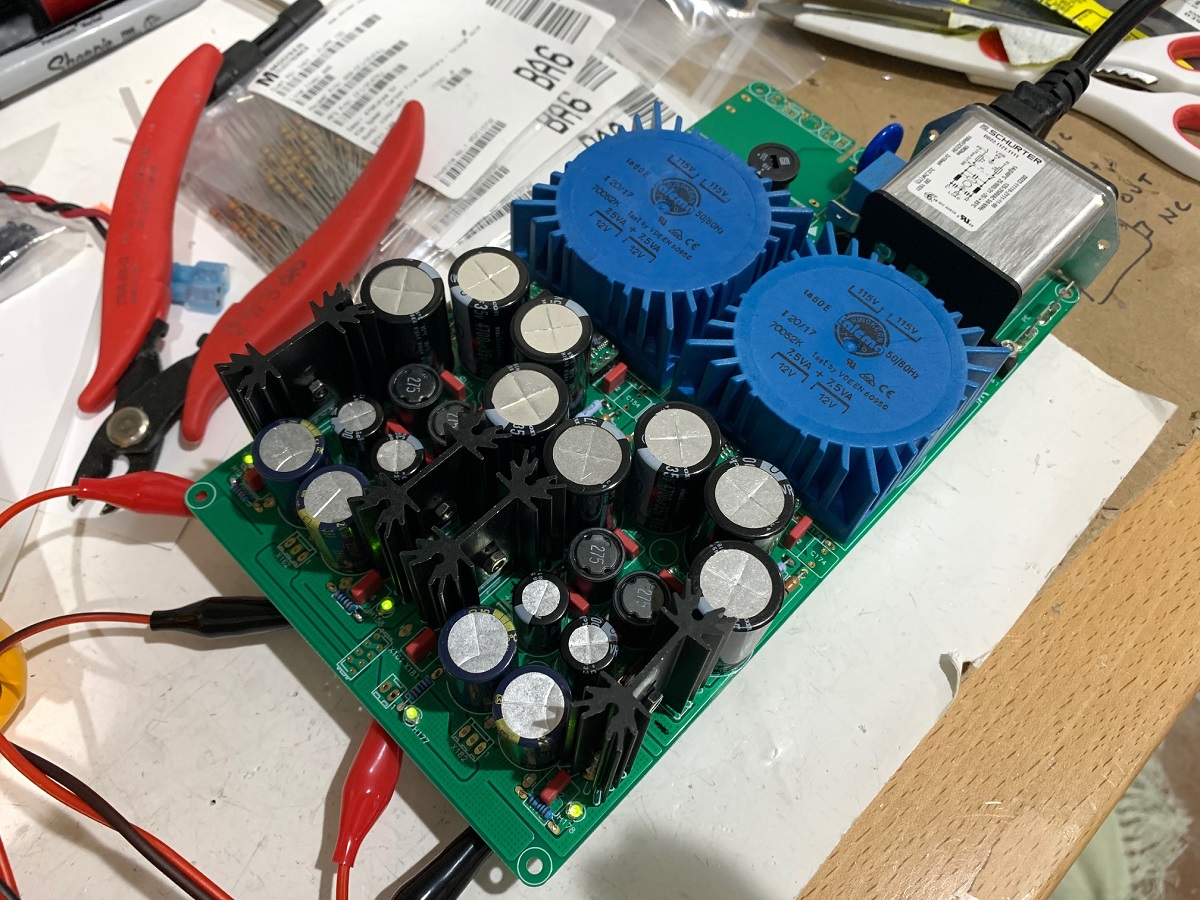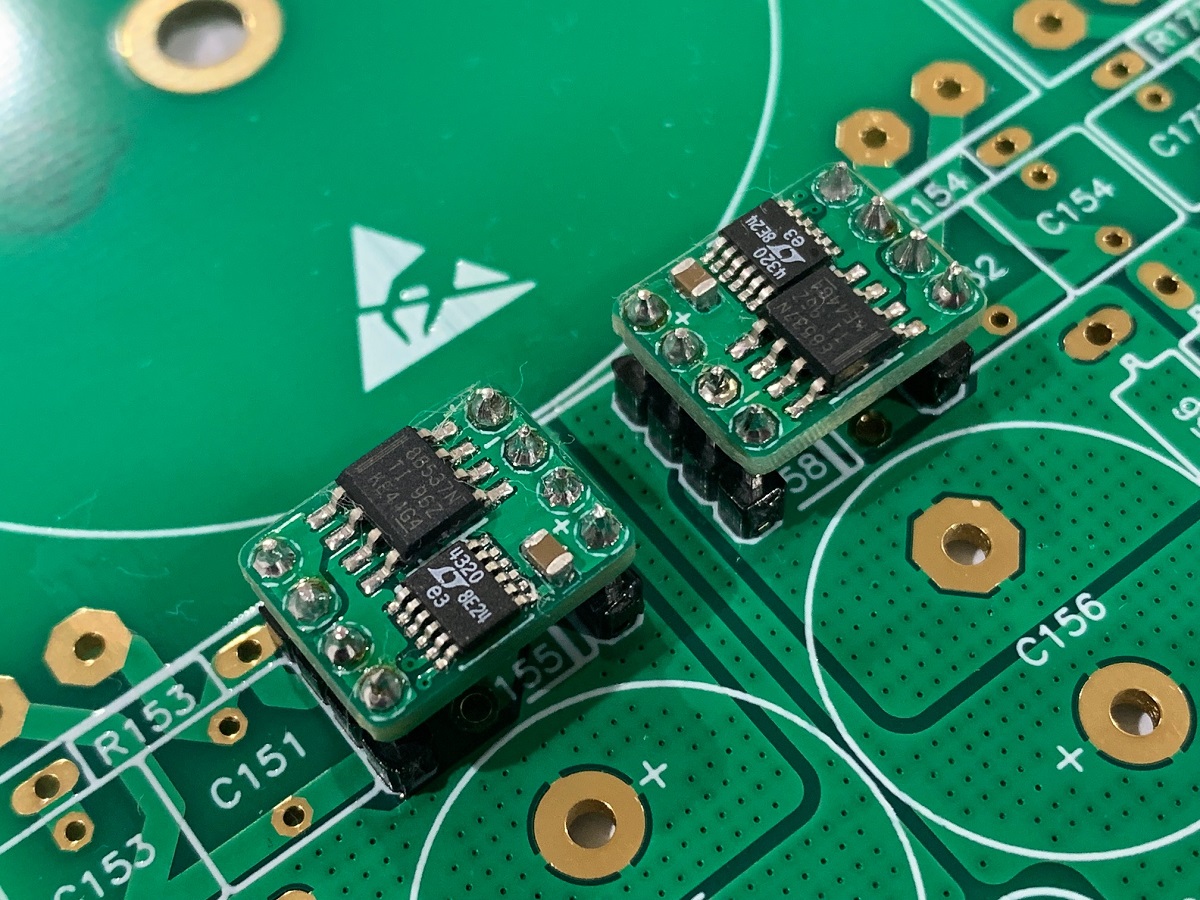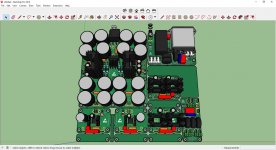Very close to finalising pcbs.
There will be two pcb designs, both will be universal choose your own bloody adventure designs.
I have tried to keep it as dumb as possible with options, each option a little less dumb, but hopefully dumb enough that a caveman would approve.
I will update this first post from time to time when I am motivated, or when people annoy the bloody hell out of me.
Some info regarding features:
This supply is a universal supply design it doesn't advocate any method over another.
It user configurable.
If you want CRC it does it
If you want CLC it does it
If you want mosfet cap multiplier it does it
If you want darlington cap multiplier it does it
If you want regulated mosfet supply it does it
If you want regulated darlington supply it does it.
You can install as many caps as you like, anywhere between C(?)C, and CCCC(?)CCCC
Board will fit 22,000uF 35V caps or lower etc.
There will be two pcb designs, both will be universal choose your own bloody adventure designs.
I have tried to keep it as dumb as possible with options, each option a little less dumb, but hopefully dumb enough that a caveman would approve.
I will update this first post from time to time when I am motivated, or when people annoy the bloody hell out of me.
Some info regarding features:
This supply is a universal supply design it doesn't advocate any method over another.
It user configurable.
If you want CRC it does it
If you want CLC it does it
If you want mosfet cap multiplier it does it
If you want darlington cap multiplier it does it
If you want regulated mosfet supply it does it
If you want regulated darlington supply it does it.
You can install as many caps as you like, anywhere between C(?)C, and CCCC(?)CCCC
Board will fit 22,000uF 35V caps or lower etc.
Last edited:
..a caveman would approve..
Hahaha soldering allowed only with ancient hot silex stone tip
The Caveman & The Astronaut on Vimeo
At the moment it will be full, but I could also include add on boards, so people could use what they already have.
The only real ripple killers are SMPSs and rectified three phase supplies. The real energy reservoir capacitors still need to be large as a 'capacitance multiplier' has no effect in keeping voltage high when the charge on reservoir capacitors drops. The action of a capacitor multiplier is more like a floating series pass regulator which is known to be vulnerable to insufficient charge storage in its powering reservoir capacitors.
In my opinion adding a capacitance multiplier is extra complications with virtually no gain. A simple [CRC]n filter does wonders, especially, when this is used to only supply the delicate circuitry in an amplifier. Adding a diode to such a filter greatly reduces the capacitance needed. I used this in my amplifier and successfully simulated its efficacy.
In my opinion adding a capacitance multiplier is extra complications with virtually no gain. A simple [CRC]n filter does wonders, especially, when this is used to only supply the delicate circuitry in an amplifier. Adding a diode to such a filter greatly reduces the capacitance needed. I used this in my amplifier and successfully simulated its efficacy.
Nice PSU Pico.
It seems to have what looks like some options for an LT4320 based bridge or MUR880 based diode bridge. All feeding C’s followed by cap Mx (?) followed by another cap bank. I see a string of NTCs for a soft start. There is a Meanwell AC/DC for auxiliary supply to run smarts. This looks to be for preamps and not power amps? Given that it’s got an active bridge, it’s a far cry from “Caveman” status - but will make a great supply. Nice JPS64 layouting of course. 🙂
Here’s another JPS64 designed “caveman” PSU that has miniature LT4320, cap bank, followed by CLC, followed by ultra low noise TPS7A4XXX LDO regulators, all in dual monoblock with dual trafos. Plus a Meanwell AC/DC (not installed yet) for auxiliary power for automation.

Micro LT4320 active bridges can populate where (optional) four 1N400x’s go:

It seems to have what looks like some options for an LT4320 based bridge or MUR880 based diode bridge. All feeding C’s followed by cap Mx (?) followed by another cap bank. I see a string of NTCs for a soft start. There is a Meanwell AC/DC for auxiliary supply to run smarts. This looks to be for preamps and not power amps? Given that it’s got an active bridge, it’s a far cry from “Caveman” status - but will make a great supply. Nice JPS64 layouting of course. 🙂
Here’s another JPS64 designed “caveman” PSU that has miniature LT4320, cap bank, followed by CLC, followed by ultra low noise TPS7A4XXX LDO regulators, all in dual monoblock with dual trafos. Plus a Meanwell AC/DC (not installed yet) for auxiliary power for automation.
Micro LT4320 active bridges can populate where (optional) four 1N400x’s go:
Last edited:
Over 352,000uF
I would say that's quite caveman for just the first stage of ONE channel of a preamp.
I'd say that's cave man enough.
This one is just the first. I did say there will be 2.
This one can also do power amp too.
I will explain some stuff later.
I would say that's quite caveman for just the first stage of ONE channel of a preamp.
I'd say that's cave man enough.
This one is just the first. I did say there will be 2.
This one can also do power amp too.
I will explain some stuff later.
Last edited:
Really curious about that diode trick. Where do you put it in the (CRC)n?
The only real ripple killers are SMPSs and rectified three phase supplies. The real energy reservoir capacitors still need to be large as a 'capacitance multiplier' has no effect in keeping voltage high when the charge on reservoir capacitors drops. The action of a capacitor multiplier is more like a floating series pass regulator which is known to be vulnerable to insufficient charge storage in its powering reservoir capacitors.
In my opinion adding a capacitance multiplier is extra complications with virtually no gain. A simple [CRC]n filter does wonders, especially, when this is used to only supply the delicate circuitry in an amplifier. Adding a diode to such a filter greatly reduces the capacitance needed. I used this in my amplifier and successfully simulated its efficacy.
Nice PSU Pico.
Nice JPS64 layouting of course. 🙂
:
JPS
Has been working his ars3 off on this one.
He has had to put up with me asking to make a million changes.
Hahahaha
I owe him lots of Australian chocolate for his efforts.
Last edited:
Really curious about that diode trick. Where do you put it in the (CRC)n?
I have used a rectifier diode in place of R in CRC
A Cap multiplier is orders of magnitude better than a Diode.
In fact a diode is not really any better than CRC (it's slightly worse) but now you have a much larger voltage drop than R, so you have some losses.
I thought it might be a good idea but it doesn't work as well as I hoped.
I guess the most attractive thing is the IV curve of the diode but only if you were a sissy and didn't use enough capacitance in the first place.
For the same voltage drop CRC is much more effective at filtering than a diode. It will depend on what your intended application is and how sissy you went with your supply. It's all about making the most appropriate choice for your application etc.
A properly designed cap multiplier is far superior.
Quite happy to show the difference in performance.
Last edited:
- Home
- Amplifiers
- Pass Labs
- The Universal Ripple Killer (The Caveman Approach)
